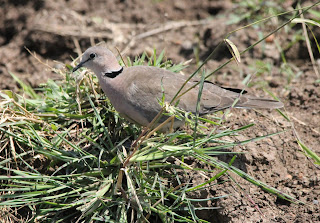We stayed in the Mara for three nights at Mara Intrepids. I commend this outstanding lodge to any who may be thinking of heading to Kenya and the Mara. It is a tranquil, delightful place and the service is outstanding. You can check it out at http://www.heritage-eastafrica.com/tented-camps/mara-intrepids/. It is also one of the best places in Kenya to see Schalow's Turaco - one of my favourite birds (oh, and Leopard!).
This year I just have to start with the mammals and reptiles! Our first "game drive" was in the evening and was simply awesome - we came across one leopard on a "kill", and then another hunting impala. We also found a hyaena den and the cubs were almost cute!





However, the next day was quite simply one of the best wildlife experiences I have ever had. We found a cheetah on a fresh "kill" (a poor little baby wildebeest), and then drove through large herds of both black wildebeest and common zebra - many of whom had recently crossed the Mara River from Tanzania into Kenya. The possibility of seeing this "great migration" in action on the river electrified the entire group.


We drove down to where the wildebeest were "massing" - an extra-ordinary sight as hundreds of thousands of these funny looking ungulates bunched around the edges of the steep slopes of the river, waiting for one brave soul to lead the way. Huge Nile crocodiles were positioning themselves for an opportunity to launch an attack once the crossing began. The air of heightening expectation was palpable, and so we waited.......... until after about an hour of indecision, suddenly .........
............... they went! Thousands of animals began pouring down the banks of the Mara. Wildebeest launched themselves into the water and made a dash for the bank on the other side. Crocodiles swept in. Some of our team witnessed the water erupting in front of them, as one enormous crocodile surfaced with half a wildebeest lodged between its jaws! We sat spellbound for what seemed an age until it was time to go. We reluctantly moved away while this most stunning spectacle continued on as more and more wildebeest were driven down the bank by an ancient compulsion to reach the lush new grass on the other side.
On the way back to Intrepids, we saw many different mammal species, including cape buffalo, impala, Thomson's and Grant's gazelle, eland, olive baboon, Masai giraffe, warthog, Kirk's dikdik and elephant. There is nothing quite like the wildlife of the Mara - it truly is the "greatest show on earth".
The next morning dawned with a sense of resignation. How could anything match the events of the day before! Well, were we in for a treat! The first thing we came across was a pride of nine lion attempting to hunt. Initally they unsuccessfully stalked a couple of buffalo, but then turned their attention to a small pod of hippo, allowing for some awesome photo opportunities. After about a half an hour, both parties called it an honourable draw and the lions moved on.
So, what about the birds?! Well, as usual, they were amazing! White-browed Robin Chats woke us each morning (along with the occasional grunt of a lion somewhere in the distance), and then we were greeted by Grey-headed Bush Shrike, Black-headed Oriole, Tropical and Slate-coloured Boubou, Superb and Ruppell's Starlings, Schalow's Turaco, Common Bulbul and Common Wattle-eye. The plains yielded Crowned, Blacksmith and Spur-winged Plovers, Fischer's Sparrow-lark, Three-banded Plover, White-bellied, Kori and Black-belied Bustards, Ground Hornbill, Helmeted Guineafowl, Black and White-headed Roughwing Swallows, Angola and Wire-tailed Swallows, African Rock and Sand Martins, White-browed Coucal, Sooty and Anteater Chat, Masai Ostrich, Bateleur and Martial Eagles, White-backed and Nubian Vultures, Ring-necked, Red-eyed and Emerald Spotted Doves, Grey Crowned Crane and Red-necked Spurfowl.
A couple of hours at the Musiara Marsh produced some of my favourites including Lilac-breasted Roller, Cinnamon-chested Bee-eater, African Fish Eagle, Pygmy Kingfisher, Saddle-billed Stork, Wattled Plover, and a fantastic view of the very rare Rufous-bellied Heron out in the open. Birding in the Mara is always incredibly rewarding - with riverine habitats and swamp systems interspersed amongst the rolling savanna grasslands. No lifers, but a brilliant time none-the-less.
Grey-headed Bush Shrike
Black-bellied Bustard
Nubian Vulture

White-browed Robin Chat
Red-necked Spurfowl
Crowned Plover
Three-banded Plover
Wattled Plover
Lilac-breasted Roller
Ring-necked Dove
Crowned Crane
The second part of our trip that involved serious birding was an afternoon spent at Lake Naivasha, located in the Great Rift Valley some 100kms west of Nairobi. Lake Naivasha is a fresh water lake, unlike many of the soda lakes spread along the floor of the Valley. It is a haven for both birds and mammals. A quiet walk through the gardens of the Lake Naivasha Country Club yielded its normal abundant array of bird-life, including African Hoopoe, Grey-backed Fiscal, White-browed Robin Chat, Cape Robin Chat, Common Drongo, Dusky Flycatcher, African Paradise Flycatcher, Grey-capped Warbler, Superb Starling and many others.
However, the best way to see birds at Lake Naivasha is to go on a boat ride. All up we saw seven different species of Heron (Black, Black-headed, Grey, Purple, Squacco, Goliath and Black-crowned), African Jacana, Yellow-billed Stork, Egrets (Great, Yellow-billed, Cattle and Little), White-breasted and Long-tailed Cormorant, Kingfishers (Giant, Pied and Malachite), Grey-headed Gull, Whiskered Tern, Great White Pelican, Hadada and Sacred Ibis, Red-knobbed Coot, Yellow-billed Duck and Hottentot Teal, Little Grebe, and the icon of the lake, the African Fish Eagle.
African Hoopoe
Grey-headed Heron
Black-crowned Night Heron
Cape Robin Chat
Squacco Heron
African Jacana
Great White Egret
Yellow-billed Stork
Purple Heron
Goliath Heron


African Fish Eagle!
And we saw some hippos up close and personal!
If you have never been to Kenya, put it on your bucket list. It is absolutely stunning! Oh, and I saw this beautiful Bronze Sunbird in Nairobi! Enjoy!



































No comments:
Post a Comment